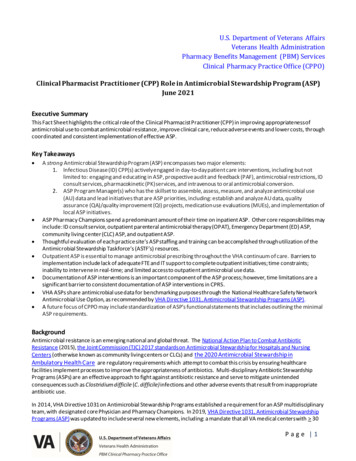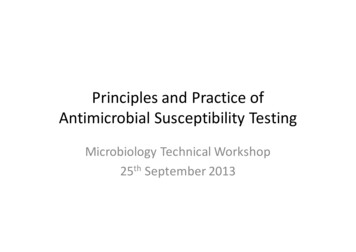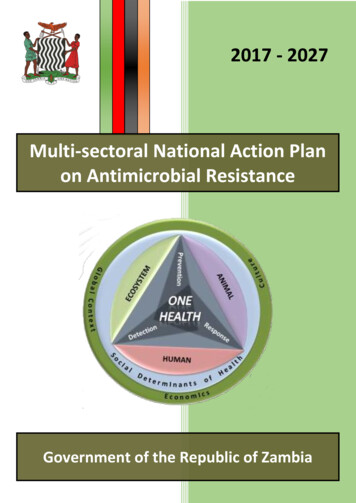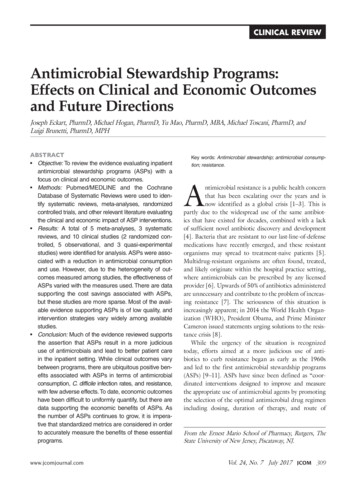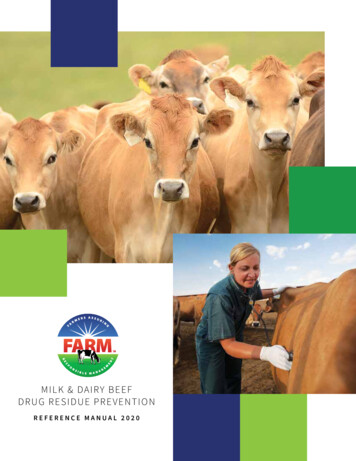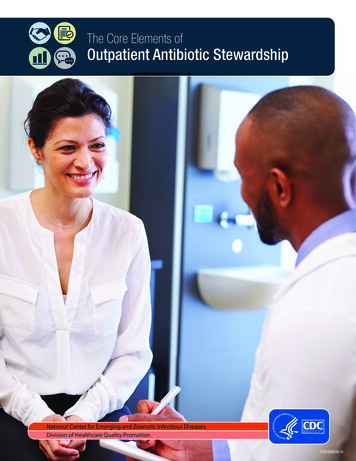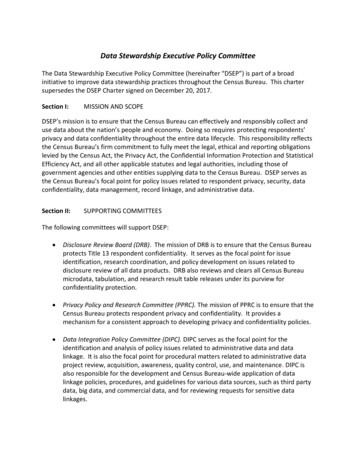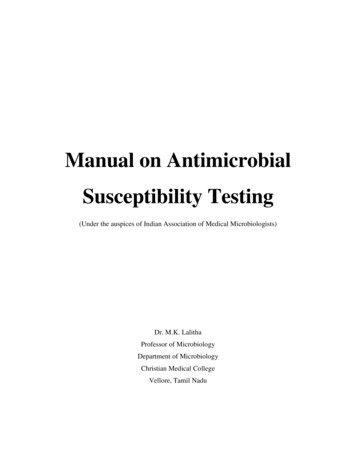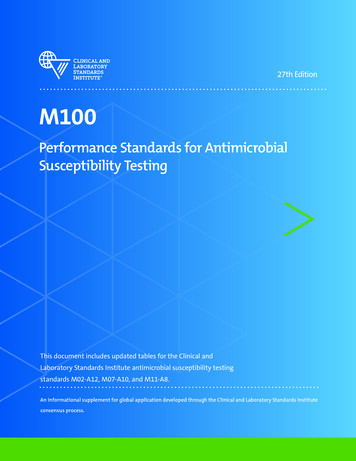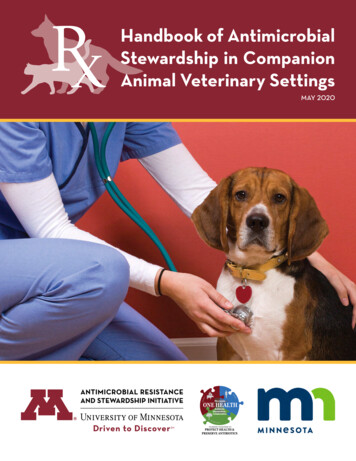
Transcription
Handbook of AntimicrobialStewardship in CompanionAnimal Veterinary SettingsMAY 2020
CitationHandbook of Antimicrobial Stewardship in CompanionAnimal Veterinary Settings is a publication of AntimicrobialResistance and Stewardship Initiative within the College ofVeterinary Medicine at University of Minnesota. The suggestedcitation format for this document is:UMN. Handbook of Antimicrobial Stewardship in CompanionAnimal Veterinary Settings, 1st ed. Saint Paul, MN: UMN, 2020.Available at https://arsi.umn.edu/handbook.Antimicrobial Resistance and Stewardship InitiativeThe Antimicrobial Resistance and Stewardship Initiative(ARSI) at the University of Minnesota connects clinicians withhigh-quality and evidence-based resources on the topicsof antimicrobial resistance, antimicrobial stewardship, andinfection prevention for veterinarians and animal owners.ARSI also conducts research to advance the practice ofantimicrobial stewardship and understand the burden ofantimicrobial use and resistance on companion animal health.Learn more at https://arsi.umn.edu.Minnesota One Health Antibiotic StewardshipCollaborativeThe Minnesota One Health Antibiotic StewardshipCollaborative (MOHASC) is comprised of over 100professionals in human, animal, and environment health, fromover 40 agencies, institutions, and organizations. Endorsed andsupported by Minnesota Department of Health, MinnesotaDepartment of Agriculture, Minnesota Pollution ControlAgency, and Minnesota Board of Animal Health since 2016,MOHASC conducts activities within a work group structureto meet the goals of the Minnesota One Health AntibioticStewardship Five-Year Strategic Plan: to communicate theimportance of antibiotic stewardship as a One Health issue toprofessionals and the public, advance stewardship in humanhealthcare, advance stewardship in animal health, and defineour “antibiotic footprint” on Minnesota’s natural environment.Volunteer members contribute over 2,000 aggregate hours toMOHASC activities each year, including time spent engagingwith members of the public on antibiotic use and resistancetopics. Everyone is welcome to sign up for the MOHASCelectronic newsletter to receive updates and resources relatedto antibiotic stewardship. Learn more at ed by:Amanda Beaudoin DVM, PhD, DACVPMMinnesota Department of Health and Department ofVeterinary and Biomedical Sciences, College of VeterinaryMedicine, University of MinnesotaJennifer Granick DVM, PhD, DACVIMDepartment of Veterinary Clinical Sciences, College ofVeterinary Medicine, University of MinnesotaEmma Leof MPHDepartment of Veterinary Clinical Sciences, College ofVeterinary Medicine, University of Minnesota2Acknowledgements:The authors would like to thank those who contributed to thisfirst edition of the Handbook. The information expressed inthis report is of the authors’ own and does not necessarilyreflect the view of their organizations.Centers for Disease Control and Prevention Cheri Grigg DVM, MPH, DACVPM; Megin Nichols DVM,MPH, DACVPM; Michelle Waltenberg DVM, MPHUniversity of Minnesota Jeff Bender DVM, MS; Lauren Bernstein MVB, MPHMinnesota Department of Health Stacy Holzbauer DVM, MPH; Leslie Kollmann CVT, JoniScheftel DVM, MPH; Ruth Lynfield MDNorth Carolina State University Erin Frey DVM, MPHUniversity of Guelph Scott Weese DVM, DVSc, DACVIMKansas Department of Health and Environment Bryna Stacey MPH, BSN, RNUniversity of Melbourne Laura Hardefeldt, BSc, BVMS, MPh, PhD, DACVIM (LargeAnimal)The authors would also like to thank Nathan Pasch(University of Minnsota) for his creative and artistic stylingand development of this report and Katie Hill (MinnesotaDepartment of Health) for her creative and artistic styling ofmany of the resources listed.
ContentsHandbook of Antimicrobial Stewardship in Companion Animal Veterinary Settings. 2Executive Summary.4Introduction.4How to Use this Guide. 5General Approach to Antimicrobial Stewardship Implementation. 5Basic Antimicrobial Stewardship Interventions. 7Core Principle 1: Commit to stewardship. 7Core Principle 2: Advocate for a system of care to prevent common diseases.9Core Principle 3: Select and use antimicrobial drugs judiciously.10Core Principle 4: Evaluate antimicrobial drug use practices.11Core Principle 5: Educate and build expertise.12Checklist for Basic Core Principle Implementation.14Intermediate Antimicrobial Stewardship Interventions.15Core Principle 1: Commit to stewardship.15Core Principle 2: Advocate for a system of care to prevent common diseases.17Core Principle 3: Select and use antimicrobial drugs judiciously.17Core Principle 4: Evaluate antimicrobial drug use practices.19Core Principle 5: Educate and build expertise.19Checklist for Intermediate Core Principle Implementation. 20Advanced Antimicrobial Stewardship Interventions.22Core Principle 1: Commit to stewardship.22Core Principle 2: Advocate for a system of care to prevent common diseases.22Core Principle 3: Select and use antimicrobial drugs judiciously.22Core Principle 4: Evaluate antimicrobial drug use practices.25Core Principle 5: Educate and build expertise.26Checklist for Advanced Core Principle Implementation.28References and Resources.30Glossary.32Acronyms.333
Executive SummaryIncreased urgency to address the global problem of antimicrobialresistance (AMR) has necessitated systematic changes in theway that antimicrobials are used. Over the last two decades,antimicrobial stewardship (AS) programs have been implementedin human healthcare settings, including hospitals, nursing homes,outpatient clinics, and dentistry. Regulatory and practice changeshave also influenced how antibiotics are used and prescribed inanimal agriculture settings. The American Veterinary MedicalAssociation (AVMA) projects that inappropriate antimicrobial usein companion animal veterinary medicine is likely as common as inhuman healthcare settings. Many of the antimicrobials prescribed,behavioral and clinical factors driving inappropriate use, andlogistics of clinical care are also similar between healthcare andclinic-based veterinary practice. Both veterinary and healthcareexperience led AVMA to establish five core principles ofveterinary AS. Because the veterinary profession is diverse, thesecore principles must be made actionable for individual veterinarysettings. This Handbook of Antimicrobial Stewardship inCompanion Animal Veterinary Settings outlines approaches thatveterinary professionals can take to implement the core principlesof AS. The Handbook is organized to help you identify feasibleactions for your facility, given the realities of your practice scope,staff, and resources. No one person or veterinary hospital canput all AS initiatives into place at once. With this guide, veterinaryprofessionals will make stepwise progress toward understandinghow antibiotics are prescribed in their facility, identifyingopportunities for improvement, and taking action to influence andmeasure change.IntroductionAntibiotics are a powerful tool for fighting and preventinginfections. However, widespread use of antibiotics has resulted inan alarming increase in antibiotic-resistant infections and a needto rely on broad-spectrum antibiotics that might be more toxic andexpensive than those usually used for treatment. Since antibioticsare often unnecessarily or inappropriately prescribed, a concertedeffort to decrease or eliminate inappropriate use can have a bigimpact on patient safety and the problem of AMR.AS is defined by AVMA as “the actions veterinarians takeindividually and as a profession to preserve the effectiveness andavailability of antimicrobial drugs through conscientious oversightand responsible medical decision-making while safeguardinganimal, public, and environmental health.” 1 Veterinarians play acritical role in combating AMR, promoting responsible antimicrobialuse (AU), and reducing the impact of resistant pathogens.AS requires commitment, leadership, communication, anddirected action informed by best-practice guidelines andsupported by clinical protocols and workflow solutions. This guideis meant to provide companion animal veterinary professionalswith interventions, resources, and strategies to implement ASprograms that incorporate these components into their uniqueclinic setting. It was developed by veterinarians at the Universityof Minnesota (UMN) Antimicrobial Resistance and StewardshipInitiative (ARSI) and the Minnesota Department of Health (MDH),with input from the Minnesota One Health Antibiotic StewardshipCollaborative and AS partners in the U.S. and beyond.14AVMA Antimicrobial Stewardship Definition and Core ciples.aspx
How to Use this HandbookThis Handbook is intended for use by veterinarypractices interested in implementing the AVMA’score principles of AS in veterinary medicine.1 Thesecore principles are based on the Centers for DiseaseControl and Prevention (CDC) core elements ofAS programs, which have been used successfullyto improve AU in healthcare settings. 2 This guideprovides a collection of concrete implementationstrategies, suggestions, and tools to implement thecore principles and is intended to be complementaryto literature reviews and other evidence-basedtools and resources. Implementation strategiesare grouped by capacity and resource level: basic,intermediate, and advanced. This will help clinicsidentify feasible actions to take at present and waysto enhance their AS practices over time.The core principles of AS include:commit to stewardshipadvocate for a system of care toprevent common diseasesselect and use antimicrobialdrugs judiciouslyevaluate antimicrobial drug usepracticesAlthough this Handbook largely uses the term“antibiotic,” all antimicrobials should be usedjudiciously. Consider how you might implement theseconcepts for antifungal, antiparasitic, and antiviralprescribing.educate and build expertiseGeneral Approach to Antimicrobial Stewardship ImplementationVeterinary clinics face several challenges to implementation of the robust AS programs that have become standard in manyhealthcare settings. There are few clinical AU guidelines, often insufficient diagnostic testing information [e.g., bacterial cultureand susceptibility (C&S)], lack of access to AU and AMR data, and often limited human and financial resources to carry out thework. Few training programs exist that focus on AS, pharmacology, data management, or quality improvement in the veterinarysetting. Although a clinic might not be able to implement all recommended aspects of an AS program, it is possible forall clinics to make stepwise progress. Such an approach can help you build the foundation of AS knowledge, awareness, andaccountability that will help your program to grow over time (Figure 1).Figure 1: Stepwise approach to implementing an AS program in a veterinary clinic5. Implement actions and assess impact4. Educate staff on AMR and AS. Convey importance,methods, and assessment of clinic intervention(s)3. Define protocols or guidelines for priority area(s)2. Identify one or a small number of priority areas1. Form ASC and identify Champion2CDC Core Elements of Antibiotic Stewardship. https://www.cdc.gov/antibiotic-use/core-elements/5
For clinics of all sizes and abilities, the first step is to form an AS committee (ASC) and identify a single AS Champion. TheASC should include clinic leadership, prescriber(s), technicians(s), clinic manager, as well as any staff with infectious disease/pharmacology training or in-depth knowledge of the clinic’s practice management software. The ASC will set initial AS priorities,identify or define protocols to support those priorities, and establish a plan for educating all staff on AMR, AS, and clinicinterventions. The ASC should meet regularly to assess priority interventions and evaluate progress of the AS program. Wherepossible, veterinary AS leaders should align the AS program with other initiatives, like promotion of preventive care and infectionprevention and control.To help clinics identify what AS activities are feasible given current resources, Table 1 categorizes activities as basic, intermediate,and advanced. Basic activities require only commitment, personnel time, and some access to technical expertise (e.g., in-personcommunication, use of published AS resources). Intermediate activities require some resources, planning, and dedicated staff.Advanced activities require an established AS program with trained staff and dedicated resources.Table 1: Categorization of AS activities by clinic resource availabilityBasicRequires commitment, personnel time, some access to technical expertise Form an ASC and define role for group and each memberCommunicate and display AS commitment to clientsFormalize use of published prescribing guidelines in clinic (e.g., urinary tract and respiratory disease, canine pyoderma)Educate veterinary staff about AMR and AS, clinic protocols, guidelines (e.g., annually and at new hire)Emphasize patient wellness and infection preventionIntermediateRequires some resources, planning, dedicated staff Generate snapshot of AU through point prevalence survey or other data collection approach Create treatment protocols for diseases without published guidelines, considering local susceptibility, expert opinion,or guidelines from other countries Implement antibiotic time-out approach for hospitalized patients Use prior-authorization for third-line antibioticsAdvancedRequires an established AS program with trained staff and dedicated resources Conduct routine AU trackingMeasure antibiotic appropriateness for priority syndromesProvide rates of overall AU and appropriateness to staff and, if possible, give individual AU feedback to prescribersEstablish system to enforce protocol useTrack outcomes of AU (e.g., infection resolution, adverse drug reactions, development of resistant infection)Conduct monitoring and evaluation of AS programThis Handbook provides specific examples of AS actions that can help veterinary clinics practice the AVMA core principles of AS.Use the stepwise framework described above to help determine which of the examples you might be able to implement in yourclinic. Try to put into practice activities that pertain to each of the five core principles.6
Basic Antimicrobial Stewardship InterventionsInterventions in the basic level are the first AS interventions that clinicsshould tackle. Completing these interventions will position a clinic forsuccess in intermediate and advanced level interventions.Core Principle 1: Commit to stewardshipForm your AS Committee.Implementation Strategiesa. Identify stakeholders for the ASC. Key representation includes clinic leadership, at least one practicing veterinarian, at leastone veterinary technician, and the clinic manager.i. If there is a staff member with specific training, or a strong interest, in infectious diseases or pharmacology, be sure toinclude him or her in the ASC.ii. Also consider including the staff member that has the best understanding of the clinic’s practice management softwareor system for keeping medical records, even if this person does not do clinical work. The ASC will need access to data onAU and diagnoses from the software system or paper records. This person can also use the software to incorporate ASactions into clinical workflow and AS messaging into client print-outs.iii. If part of a clinic group, consider including a corporate representative who can share perspectives and experiences ofother clinics and, perhaps, provide leadership or financial support for AS initiatives.b. Meet regularly (e.g., once monthly) as the ASC to assess priority interventions and evaluate progress of the AS program.c. Educate all staff on the problem of AMR and the concept of AS.ResourcesARSI: Sample Letter to Staff: Communicate Antibiotic Stewardship Priorities. https://arsi.umn.edu/cliniccommitmentMDH: Fact Sheet: Antibiotic Use in Companion Animal Veterinary Practice bioticresistance/animal/animalcafs.pdfARSI: AMR and AS Background Information, Fact Sheets, and Research Highlights. https://arsi.umn.edu/as-generalIdentify an AS Champion.Implementation Strategiesa.Identify a single veterinarian to be the AS Champion. This veterinarian will lead the work of the ASC and be the AS pointof-contact for staff, clients, other clinics, and, where relevant, corporate leadership. The AS Champion is not responsible for allpatients on antimicrobials; individual clinicians maintain primary client communication and primary case responsibility for theirpatients. The AS Champion could fulfill the role of primary contact with the reference microbiology laboratory the clinic uses.b. Draft a written statement that identifies the AS Champion for clinic staff and explains the AS Champion’s role.c. Display a commitment poster, to be seen by clients and staff, that identifies the AS Champion and states the clinic’scommitment to AS.ResourcesARSI: Veterinary Antimicrobial Stewardship Roles and Responsibilities: Use this guidance document to define contributions of the ASChampion and all other staff. https://arsi.umn.edu/asrolesARSI: Sample Email Introducing our Clinic’s Antimicrobial Stewardship Champion: Sample email to introduce the antimicrobialstewardship leader to clinic staff. https://arsi.umn.edu/championannouncementARSI: Customizable AS Champion Commitment Poster: Download the Microsoft PowerPoint template and add your own images andlogos. https://arsi.umn.edu/championpostertemplate7
Make a public commitment to your clients.Implementation Strategiesa. Send a letter or email to clients about your clinic’s commitment to AS policies.b. Use talking points to discuss appropriate AU with clients.c. Publically display your clinic’s commitment to AS in examination and waiting rooms (Figure 2). In human healthcare settings,exam room commitment posters with a clinician’s photo have been linked to improved AU. 3 Such posters hold the facility andprescribers accountable, inform patients about the importance of using antibiotics only when needed, and provide a stimulusfor conversations about AU.d. Include a clinic AS commitment statement in bylines of emails and in documents sent home with clients. Or, incorporate the“O.W.N.” logo (“Only When Needed”) designed for pet health (Figure 3). This logo is a concise and attractive way to raise clientawareness. It can be used in email footers, visit statements, and commitment posters.e. Put up a special poster for U.S. Antibiotic Awareness Week (USAAW), which occurs annually in November. This annualevent is meant to raise awareness about responsible AU.ResourcesARSI: Sample Commitment Letter to Clients: Demonstrate your commitment to AS by sending this customizable letter to SI: Veterinary Antimicrobial Use Talking Points: Examples of effective engagement strategies, contingency plans, and positive carerecommendations to support clinician-client communication. https://arsi.umn.edu/talkingpointsMDH: Customizable Commitment Posters: Download the Microsoft PowerPoint templates and add your own images and logos. Or, useone of the ready-made posters. resistance/animal/index.html#commitMDH: Electronic image files of “Only When Needed, O.W.N.” antibiotic awareness logo: Download these files and use them freely inyour own materials and messaging. resistance/own/index.htmlCDC: USAAW Toolkit: Learn more about this annual event, and download electronic lkit.htmlAVMA: Clinic Posters: Be Careful with antibiotics.aspxFigure 2: Sample AS commitment posters38Meeker et al. Nudging guideline-concordant antibiotic prescribing: a randomized clinical trial. JAMA Intern Med. 2014 March; 174(3):425–431.
Define (and redefine) your hospital AS priorities.Implementation Strategiesa. Set AS priorities for initial intervention, and revise these as progress is made. Start simply and build your priority list overtime. Consider:i. Increase awareness, and encourage use, of International Society for Companion Animal Infectious Diseases (ISCAID)guidelines.ii. Improvement in client-staff communication on AU.b. Identify protocols, existing or clinic-defined, to support those priorities.c. Educate staff on AS priorities and protocols.i. For clinical staff, provide specific training on how AS actions should be incorporated into workflow and documented inpatient records.ii. Have staff sign each protocol after education and training.iii. Require new staff to receive training on clinic AS policy, priorities, and protocols.iv. Renew training for staff on an annual basis, or as otherwise defined by the ASC.ResourcesISCAID: Prescribing guidelines: Guidelines for canine and feline respiratory tract and urinary tract disease and for canine superficialbacterial folliculitis include recommendations for diagnostic specimen collection. Find them under the ARSI “Antimicrobial PrescribingGuidelines” tab. https://arsi.umn.edu/as-resourcesCore Principle 2:Advocate for a system of care to prevent common diseasesEducate clients on the importance of preventative care.Implementation Strategiesa. Promote the importance of annual wellness visits for disease prevention and diagnosis and for overall pet health.b. Make clear the benefit of vaccination and preventive care. Educate clients on the clinical impact of vaccine-preventablediseases, like distemper, parvovirus, kennel cough, influenza, leptospirosis, Lyme, feline leukemia virus (FeLV), and felineimmunodeficiency virus (FIV).i. Consider sharing de-identified stories of pets seen in your clinic that have suffered from preventable conditions. Youmight do this as part of email updates or by posts on social media.ii. Share population-level surveillance data on preventable diseases, if available, from sources like Companion AnimalParasite Council.c. Empower your clients to keep their animals healthy by feeding a nutritious diet, providing exercise, maintaining a healthy petweight, and investing in preventive dental care.d. In AS messaging, inform owners that good preventive care can reduce the need for treatment with antibiotic drugs. Someexamples include Lyme disease and bacterial complications from vaccine-preventable viral respiratory infections.ResourcesAVMA: Pet Care website: Use AVMA’s content to educate owners on the importance of wellness exams, preventable diseases, andmore. aspxAVMA: Pet Dental Care website. al-Care.aspxAmerican Animal Hospital Association (AAHA) Guidelines: Find evidence-based information to guide care and communication aboutclinically relevant topics. -guidelines/AAHA: 2019 AAHA Canine Life Stage Guidelines: Find definitions, checklists, client talking points, and more in this comprehensivetoolkit. nine-2019/life-stage-canine-2019/AAHA: 2010 AAHA Feline Life Stage Guidelines: Find wellness visit how-to, communication for overcoming barriers to clinic visits, andmore in this comprehensive toolkit. line-configuration/background-and-goals/Companion Animal Parasite Council: This website has maps that show the prevalence of parasitic diseases that can be prevented:https://capcvet.org/Banfield Pet Hospital: State of Pet Health. https://www.banfield.com/state-of-pet-healthMDH: Fact Sheet: Antibiotics and Your Pets: What You Should Know.9
resistance/animal/abxpetfs.pdfFederation of European Companion Animal Veterinary Associations: Advice to Companion Animal Owners on Responsible use ofAntibiotics and Infection Control. FECAVA petowners 2018 LR1.pdfPrevent healthcare-associated infections in your hospital.Implementation StrategyReview your clinic infection prevention and control (IPC) plan with staff. Infections that occur within healthcare settings,including veterinary clinics, might be more likely to be resistant to antibiotics. Not only is IPC an expectation for patient care, butit also plays a major role in preventing AU and resistant infections.ResourcesARSI: List of Infection Prevention and Control Resources. https://arsi.umn.edu/ipc-resourcesAAHA: 2018 Infection Prevention, Control, and Biosecurity Recommendations. n-and-biosecurity-guidelines/Canadian Committee on Antibiotic Resistance Infection Prevention and Control: Best Practices for Small Animal Veterinary /OAHN-IPC-Guide-SB-Final-Jan0820 All tagged-SUR.pdfCore Principle 3:Select and use antimicrobial drugs judiciouslyProvide clinical guidance for responsible antimicrobial use.Implementation Strategiesa. Share broad concepts of responsible AU with veterinarians an
outpatient clinics, and dentistry. Regulatory and practice changes have also influenced how antibiotics are used and prescribed in animal agriculture settings. The American Veterinary Medical Association (AVMA) projects that inappropriate antimicrobial use in companion animal veterinary medicine is likely as common as in human healthcare settings.
